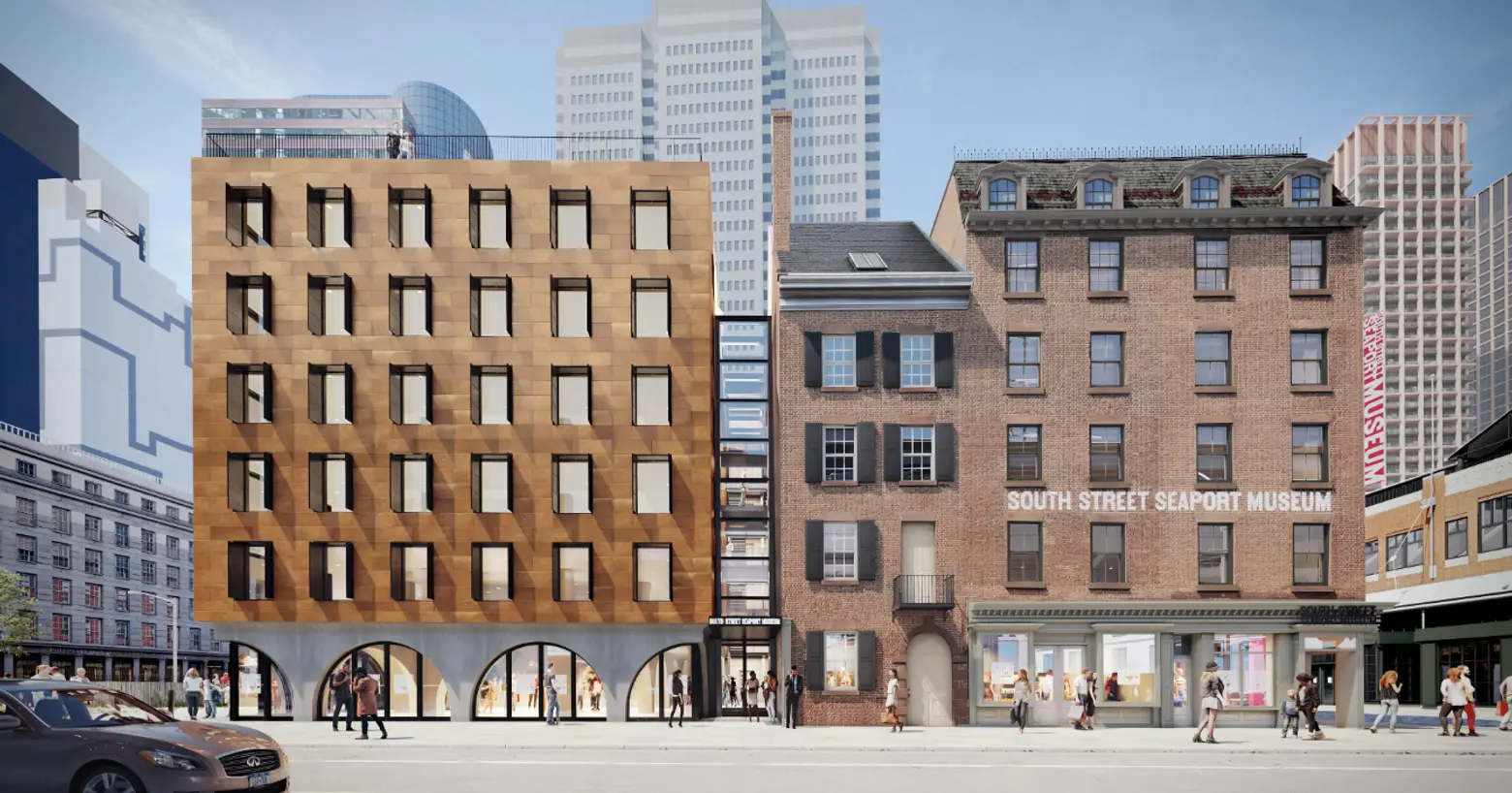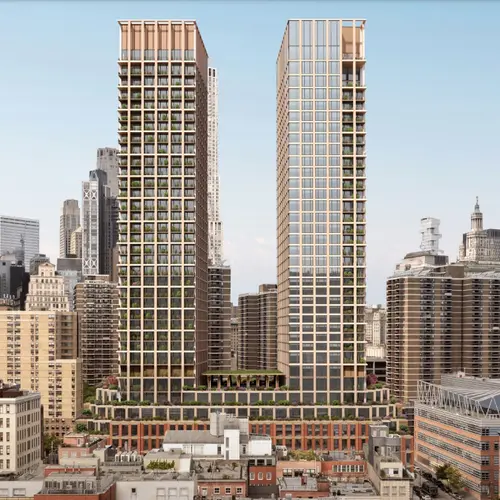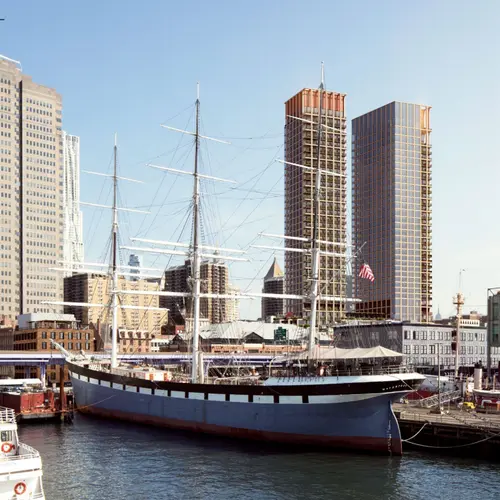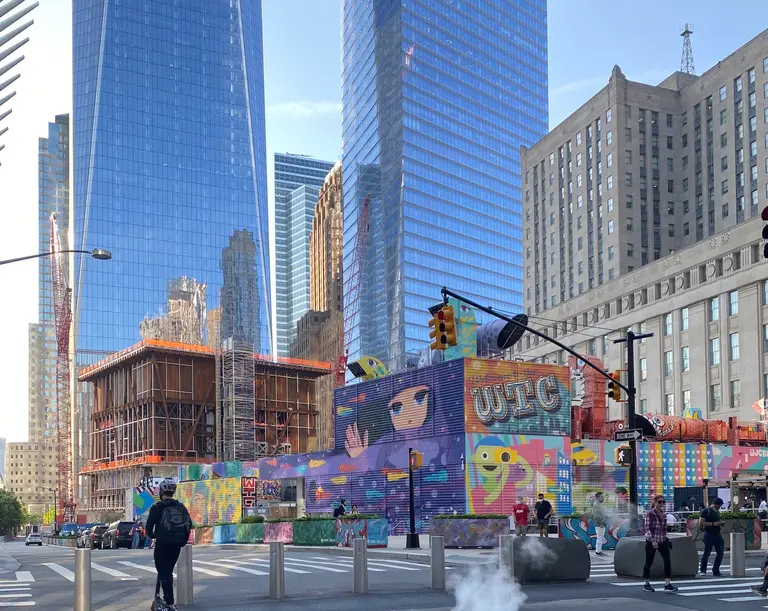See new renderings of controversial South Street Seaport towers and museum expansion

All renderings courtesy of Skidmore, Owings & Merrill / Howard Hughes Corporation
Plans to construct two 470-foot towers and expand a museum in the historic South Street Seaport neighborhood were met with mixed feedback during a public Landmarks Preservation Commission hearing on Tuesday. The Howard Hughes Corporation presented a proposal for a $1.4 billion mixed-use project consisting of rentals, condos, and office space at 250 Water Street, as well as a new building for the South Street Seaport Museum at 89 South Street. While those in favor of the project say it will bring much-needed affordable housing to a neighborhood that has almost none and help the museum stay open, opponents claim the project is out of scale with the rest of the district. New renderings of the proposed expanded museum show plans for a copper-clad exterior, flexible gallery space, an outdoor terrace, and a connection to the historic structure.

View from Brooklyn Bridge Promenade


View from Beekman Street
Designed by Skidmore, Owings & Merrill, the two residential towers would have 360 units of housing, with at least 100 apartments set aside for families earning 40 percent of the area median income. It would be the first affordable housing built in the district under the city’s Mandatory Inclusionary Housing program.
The proposed two-tower building includes a podium of six floors, designated for commercial office use, with a pair of 38-story residential towers on top. According to the developer, 20 percent of the units will be affordable under MIH and the remaining homes will be market-rate condos. The ground floor will consist of 8,000 square feet of retail and 5,000 square feet of community space.



Inspired by the port’s historic ships and other waterfront buildings, the exterior of the museum would be clad in copper
Howard Hughes signed a long-term lease with the city in 2010 to redevelop the waterfront neighborhood. The developer has opened the Pier 17 complex, with the Tin Building, formerly home to the Fulton Fish Market, expected to open later this year. The group first bought the vacant lot in 2018 for $180 million and had originally proposed a single tower for the site that would be nearly 1,000 feet tall. The idea was swiftly rejected by local residents, elected officials, and the Seaport Museum.
Developing the site is not a new idea. The LPC has rejected nine different proposals for 250 Water Street over the last 25 years.
The plan would involve the transfer of unused development rights from Howard Hughes’ Pier 17 and Tin Building sites to 250 Water Street. The $50 million expected from the development rights sale will be provided to the museum, which has suffered a number of financial difficulties in the last 20 years, including 9/11, the 2008 financial crisis, Hurricane Sandy, and the coronavirus pandemic. Jonathan Boulware, the president of the South Street Seaport Museum, said this project ensures the museum’s survival.
Phase one of the project includes reopening the museum’s art galleries that have been closed since Hurricane Sandy, moving the entrance to the corner of South and Fulton Streets, and making needed restoration improvements. The second phase involves the construction of a new building at 89 South Street that would be connected to the historic structure and display artifacts from the museum’s collection.



Council Member Margaret Chin and Manhattan Borough President Gale Brewer testified in favor of both applications and called the project an important opportunity to preserve both the historic district and the museum. “Without the museum, there is no historic district,” Chin said during Tuesday’s meeting.
Seth Pinsky, former head of the city’s Economic Development Corporation and now chief executive officer of the 92nd Street Y, Robert Tierney, former chair of the Landmarks Preservation Commission, Kathryn Wylde, the president of the Partnership for New York City, and Jessica Lappin, president of the Downtown Alliance, all voiced support for the Howard Hughes proposal.

But Manhattan Community Board 1 last month recommended that Landmarks reject the project from Howard Hughes, claiming it would reduce the size of the Historic Seaport District by 10 percent.
In an advisory resolution, the board also said the 470-foot towers are out of scale with the rest of the neighborhood. “There are better ways to help the Seaport Museum without destroying this historic district and the City should fully explore all potential solutions to generate funds for the museum,” the board wrote.
The Historic Districts Council expressed similar concerns over the scale of the towers at 250 Water Street as well as the design of the new museum space at 89 South Street, which is also currently vacant.
“We feel quite strongly that this conceptual plan is a Trojan Horse, with the hidden cost of irreparably damaging the historic district and setting a dreadful precedent for the regulation of historic districts in New York City going forward,” Simeon Bankoff, the executive director of the HDC, testified on Tuesday.
Regarding the two towers, Bankoff called the proposal a “truly monstrous edifice.” He added: “The applicants are not driven to propose this plan by a need to ‘complete the historic district’ or by a deeper understanding of what previous Landmarks Commissions intended – they want to make the most money remotely possible from their investment.”
Some residents who are against the residential towers are open to moving an NYPD tow pound to the parking lot instead. As Gothamist first reported, the Seaport Coalition has put together a proposal for the site called “Resiliency Park.” Michael Kramer, a member of the coalition, told the website that the tow pound is a “reasonable alternative” to the project. A Change.org petition opposing the development launched by the Coalition has garnered over 7,000 signatures as of Tuesday morning.
But the team at Howard Hughes is arguing the project would provide economic benefits to the neighborhood and the city overall as it continues to recover from the ongoing pandemic. According to the developer, the construction of 250 Water Street would generate $1.8 billion in economic output annually and create 2,000 construction jobs. Overall, the site could create nearly 2,500 full and part-time permanent positions and ultimately generate $645 million in economic output for the city.
The LPC said it will make a decision on the project next Tuesday. The uniform land use review procedure could begin as early as the spring, with construction starting in 2022, if approved.
RELATED:
- $1.4B South Street Seaport proposal includes two mixed-use towers with affordable units
- Open-air cafe proposed along the East River in historic South Street Seaport
- Demo permits filed for South Street Seaport site of proposed 1,436-foot supertall
All renderings courtesy of Skidmore, Owings & Merrill / Howard Hughes Corporation








































